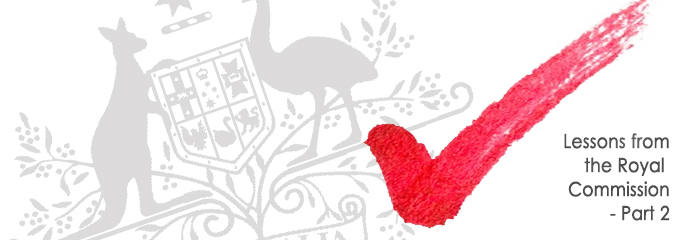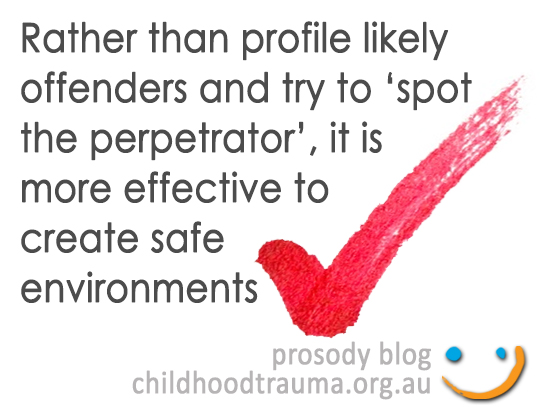
Lessons from the Royal Commission Part 2

This article was authored by David Ross,
Consultant with the Safeguarding Children Program.
In our earlier blog (Part 1) we suggested that whilst the Royal Commission has not yet completed its investigations or made any recommendations, it has compiled a body of information that provides significant insights into the nature of institutional abuse. In this blog we outline some of those important insights from the Royal Commission in relation to the nature and prevalence of child sexual abuse; perpetrators and organisational awareness of abuse.
Based on research it had undertaken the Royal Commission noted that:
- Most victims are abused by someone they know.
- There are significant differences between victims dependent on their gender in terms of who they are abused by:
- Girls are more likely than boys to be abused by a family member. More than 50% of perpetrators of abuse against girls were male relatives compared to 21% for boys
- Twice as many boys who were sexually abused were abused by a stranger (18%) compared with girls (9%).
These early findings add to our understanding of the dynamics of institutional abuse. Further research is needed to understand how they contribute to our efforts to prevent institutional abuse.
The Royal Commission highlighted the importance of organisational awareness of child abuse and how it occurs.
Although knowledge and awareness are important, a key message from our perspective is that it is more effective to create a safe environment and reduce environmental and situational risk factors that influence whether abuse can occur. Rather than profile likely offenders and try to ‘spot the perpetrator’, it is more effective to create safe environments.
 Abusers come in all shapes and sizes, ages and genders. For example, the traditional view is that abusers are serial predators. However most are opportunistic or situational perpetrators who are more likely to abuse when certain environmental factors are present. Contrary to the traditional view, some perpetrators are peers. Children under the age of 17 committed up to 16% of child sexual abuse offences (Australian police statistics 2003-2004).
Abusers come in all shapes and sizes, ages and genders. For example, the traditional view is that abusers are serial predators. However most are opportunistic or situational perpetrators who are more likely to abuse when certain environmental factors are present. Contrary to the traditional view, some perpetrators are peers. Children under the age of 17 committed up to 16% of child sexual abuse offences (Australian police statistics 2003-2004).
Organisations must have a widely shared and valid understanding of abuse. Part of this understanding of abuse should include an understanding that perpetrators may follow patterns of behaviour that can be identified as concerning, for example targeting, grooming and maintaining secrecy. Knowing and understanding these patterns helps organisations to put policy and procedure in place that will create safe and protective environments and prioritise the safety of children.
What is grooming?
Grooming can be defined as behaviours used to prepare a child (and possibly the adults around them) with the intention of sexually abusing the child. It has two main elements of:
- building a trusting relationship with child and carer, and
- isolating the child to abuse him or her.
It involves a graduation from attention-giving and non-sexual touching to increasingly intimate and intrusive behaviours and development of a ‘special relationship’ that allows them to spend time alone with children or outside the work role.
Perpetrators often know victims for a year of more before the first incident takes place. So, there can be an opportunity to prevent abuse if early signs are identified and reported. Perpetrators take advantage of ambiguities over boundaries and behaviour eg appropriate touch, conversations and supervision, to test and push the boundaries. If the boundaries are weak opportunities for abuse are created.
Awareness of the way abuse occurs can help institutions identify and report concerning and inappropriate behaviours and prevent risks and incidents of abuse. It is often difficult to recognise or distinguish grooming from seemingly innocent actions. Seemingly innocent, but nonetheless, inappropriate behaviour may be damaging to a child or young person even if it is not part of a grooming process. Thus, clearly identified organisational boundaries for behaviour will enable organisations to more quickly and easily identify and address inappropriate behaviour rather than to try to identify whether the behaviour is part of a grooming process.
Future blogs will discuss what is required in organisations to enable the identification and management of inappropriate behaviour.
If you would like help to audit and update your organisations policies, please contact safeguardingchildren@childhood.org.au
